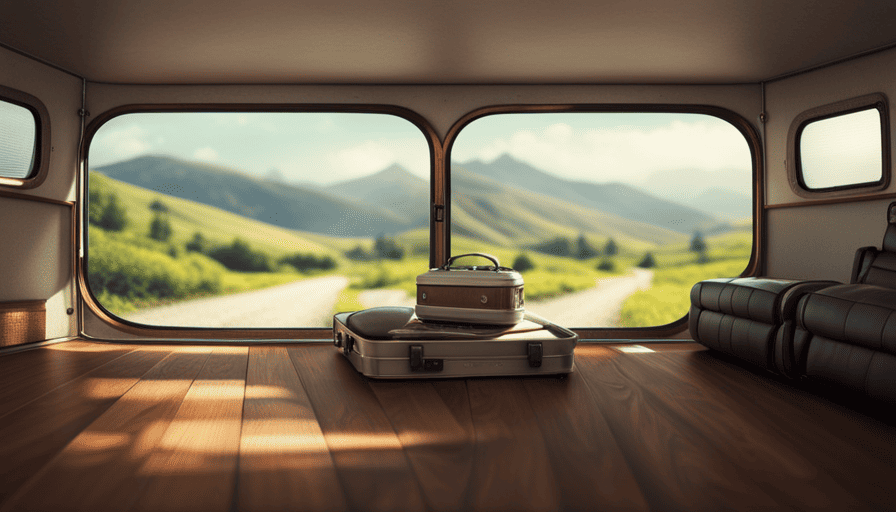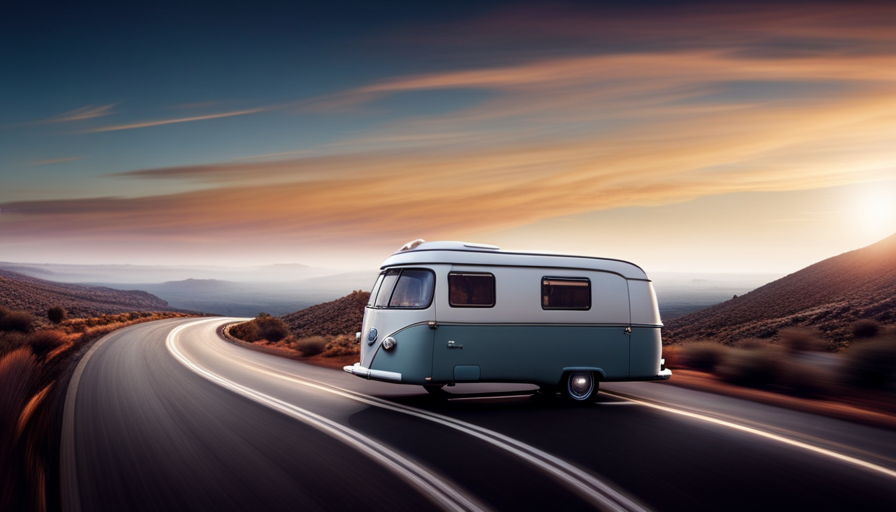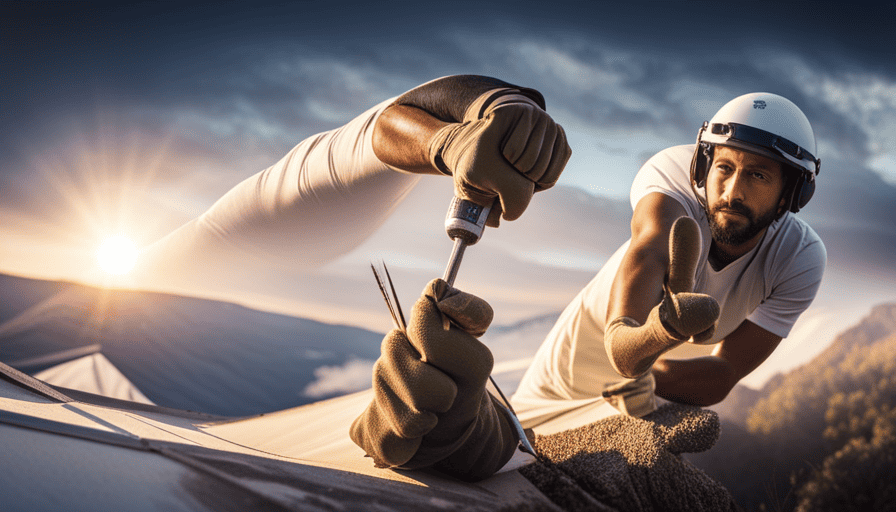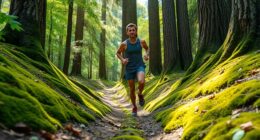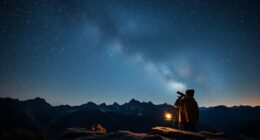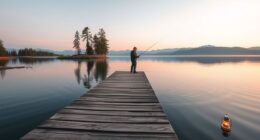Did you know that in the United States, more than 400 deaths and 50,000 visits to the emergency department are caused by carbon monoxide poisoning each year? This dangerous gas is difficult to detect and can be especially deadly in closed spaces like campers.
In this article, we will explore the various sources of carbon monoxide in campers and discuss how to prevent it.
One of the main culprits is propane-powered appliances, such as stoves, ovens, and refrigerators. These appliances can produce carbon monoxide if they are not properly maintained or if there is a leak in the propane system.
Another common source is generators, which are often used to power electrical devices in campers. These generators emit carbon monoxide through their exhaust, so it is crucial to place them in a well-ventilated area.
Engine exhaust, campfires, propane heaters, cigarette smoke, blocked ventilation, and faulty equipment are other potential sources of carbon monoxide in campers.
It is essential to be aware of these risks and take necessary precautions to ensure the safety of everyone inside the camper. By educating ourselves and others about the dangers of carbon monoxide, we can enjoy our camping trips without putting ourselves at risk.
Key Takeaways
- Propane-powered appliances can produce carbon monoxide if not maintained or if there is a propane leak.
- Generators emit carbon monoxide and should be placed in well-ventilated areas.
- Sources of carbon monoxide in campers include engine exhaust, campfires, propane heaters, cigarette smoke, blocked ventilation, and faulty equipment.
- Proper ventilation is crucial when using propane-powered appliances in campers.
Propane-Powered Appliances
Propane-powered appliances, like stoves and heaters, can be a hidden source of carbon monoxide in your camper. It’s important to understand how these appliances work and the potential dangers they pose.
One of the main culprits is a propane tank. If the tank is damaged or improperly connected, it can lead to a gas leak. This leakage can release carbon monoxide into the air, putting you at risk of carbon monoxide poisoning.
To prevent this, it’s crucial to regularly inspect your propane tank for any signs of damage or wear. Make sure that all connections are secure and free from leaks. Additionally, it’s essential to properly ventilate your camper when using propane-powered appliances. Open windows or vents to allow fresh air to circulate and prevent the buildup of carbon monoxide.
Transitioning to the next section about generators, it’s important to note that they can also be a potential source of carbon monoxide in your camper. While generators can provide power for your appliances and electronics, they emit exhaust fumes that contain carbon monoxide. Therefore, it’s crucial to place the generator outside the camper and away from any windows or vents. This will help prevent the deadly gas from seeping inside and endangering your health.
Generators
While running, generators can emit a silent and deadly gas that poses a serious threat to those inside the camper. Therefore, it’s crucial to prioritize generator maintenance and take necessary precautions to ensure the safety of everyone on board.
Regularly inspecting and servicing the generator can help prevent carbon monoxide leaks. This includes checking for any loose connections, damaged exhaust pipes, or clogged air filters. Additionally, it’s essential to install carbon monoxide detectors inside the camper to provide early warnings in case of gas leakage. These detectors should be placed in areas where people sleep or spend a significant amount of time.
Proper generator maintenance and the use of carbon monoxide detectors can significantly reduce the risk of exposure to this dangerous gas. However, it’s important to remember that generators aren’t the only potential source of carbon monoxide in a camper. Another common culprit is the engine exhaust.
In the next section, we’ll discuss how engine exhaust can also contribute to the presence of carbon monoxide and the precautions that should be taken to minimize its impact.
Engine Exhaust
When it comes to engine exhaust in a camper, there are three key points to keep in mind. First, it’s crucial to avoid idling your vehicle inside the camper to prevent the buildup of carbon monoxide.
Secondly, ensure proper ventilation by opening windows or using vents to allow fresh air to circulate and exhaust fumes to escape.
Lastly, regularly inspect and maintain your vehicle to ensure that the exhaust system is functioning properly and there are no leaks or blockages that could lead to carbon monoxide poisoning.
By following these guidelines, you can ensure a safe and healthy environment inside your camper.
Avoid Idling Your Vehicle Inside the Camper
To make the most of your camper experience, remember not to idle your vehicle inside – it’s a surefire way to keep carbon monoxide at bay and enjoy your trip to the fullest! When you idle your vehicle inside the camper, the engine continues to produce exhaust fumes containing carbon monoxide. This can lead to serious health risks, including carbon monoxide poisoning, which can be fatal.
To avoid idling and the associated health risks, follow these simple tips:
-
Park your vehicle outside the camper: By parking your vehicle outside, you ensure that exhaust fumes are released into the open air instead of being trapped inside the confined space.
-
Use a carbon monoxide detector: Install a carbon monoxide detector inside the camper to alert you if carbon monoxide levels become dangerous.
-
Educate yourself and your fellow campers: Make sure everyone in your group understands the importance of avoiding idling and the potential consequences of carbon monoxide exposure.
By following these guidelines, you can minimize the risks associated with carbon monoxide and ensure a safe and enjoyable camping experience. To further safeguard against carbon monoxide buildup, it’s crucial to ensure proper ventilation.
Ensure Proper Ventilation
Make sure you don’t underestimate the importance of having good ventilation in your vehicle to keep yourself and others safe during your camping trip. Proper ventilation is crucial in preventing the buildup of carbon monoxide, a potentially deadly gas.
To ensure proper ventilation, regularly inspect and maintain your vehicle’s ventilation system. This includes checking the air filters, cleaning any debris or obstructions from vents, and ensuring that the system is functioning properly.
In addition, it’s important to take safety precautions such as opening windows or roof vents while cooking or using any gas-powered appliances inside the camper. By maintaining good ventilation and following these safety measures, you can significantly reduce the risk of carbon monoxide poisoning.
Transitioning into the next section, regularly inspecting and maintaining your vehicle is another crucial step in preventing carbon monoxide buildup.
Regularly Inspect and Maintain Your Vehicle
Don’t overlook the importance of regularly inspecting and maintaining your vehicle to ensure a safe and worry-free camping experience. Inspecting vehicles for potential carbon monoxide leaks is a crucial step in preventing any harmful situations.
Start by checking the muffler and exhaust system for any signs of damage or corrosion, as these can lead to carbon monoxide leaks. Additionally, inspect the engine compartment for any loose or damaged parts that could potentially cause a leak. It’s also essential to regularly replace the air filters and ensure proper functioning of the ventilation system.
Maintenance tips include scheduling regular tune-ups and oil changes, as well as keeping an eye on the vehicle’s overall performance. By following these guidelines, you can significantly reduce the risk of carbon monoxide exposure while enjoying your camping adventures.
Transitioning to the next section, let’s now discuss the potential dangers of campfires.
Campfires
Imagine sitting around a crackling campfire, smelling the burning wood and cozying up in your camper. Little do you know, that same campfire could be releasing dangerous carbon monoxide into your living space, silently putting you at risk.
Campfires are a staple of outdoor camping, but it’s crucial to prioritize campfire safety in order to prevent carbon monoxide buildup.
To begin, it’s essential to ensure proper ventilation when setting up a campfire. Choose an open area away from any obstructions, like trees or buildings, to allow for adequate airflow. Additionally, avoid lighting a fire in enclosed spaces like tents or campers, as this can lead to a buildup of carbon monoxide.
Furthermore, always keep a close eye on the fire and make sure it’s fully extinguished before going to bed or leaving the campsite. Use water or sand to completely put out the flames and prevent any smoldering embers from producing carbon monoxide.
By following these campfire safety guidelines, you can enjoy the warmth and ambiance of a crackling fire without the risk of carbon monoxide poisoning.
In the next section, we’ll discuss another potential source of carbon monoxide in campers: propane heaters.
Propane Heaters
Propane heaters, commonly used for warmth in outdoor camping, can pose a hidden danger if not properly managed. It’s crucial to understand propane heater safety to prevent the risk of carbon monoxide poisoning.
Carbon monoxide is a colorless and odorless gas that can be emitted from propane heaters when they’re not functioning correctly or if there’s inadequate ventilation.
To ensure propane heater safety, it’s essential to follow a few guidelines. Firstly, always use propane heaters in well-ventilated areas to allow the gas to dissipate properly. Never use them in enclosed spaces such as tents or campers without proper ventilation.
Additionally, it’s vital to regularly inspect and maintain the heater, ensuring that all connections are secure and there are no leaks. Be cautious when handling and storing propane tanks, ensuring they’re kept upright and away from any ignition sources.
By following these propane heater safety measures, you can significantly reduce the risk of carbon monoxide poisoning while enjoying the warmth they provide during outdoor camping.
Next, let’s discuss another potential source of carbon monoxide in campers – barbecues.
Barbecues
Grilling up a delicious meal outdoors on a sunny day is a favorite pastime for many campers. However, it’s important to prioritize barbecue safety to avoid the risk of carbon monoxide poisoning.
When using a barbecue in a camper, there are several precautions that should be followed. Firstly, it’s crucial to always use the barbecue in a well-ventilated area. This means ensuring that there’s enough fresh air circulating around the barbecue to prevent the buildup of carbon monoxide.
Additionally, it’s important to never use a barbecue inside the camper or in any enclosed space. This can lead to a dangerous accumulation of carbon monoxide, which can be fatal.
Another important safety measure is to never leave the barbecue unattended while it’s in use. It’s also essential to properly extinguish the barbecue after use, ensuring that all flames and hot coals are completely put out.
By following these campfire precautions, campers can enjoy a safe and enjoyable grilling experience.
Moving on to the next section about cigarette smoke, it’s important to also be aware of the potential risks it poses in a camper.
Cigarette Smoke
Moving on from the discussion of barbecues, let’s now delve into another potential source of carbon monoxide in campers: cigarette smoke. While it may seem obvious that smoking inside a camper can lead to increased levels of carbon monoxide, it’s important to understand the specific reasons behind this danger.
Cigarette smoke contains numerous harmful chemicals, including carbon monoxide. When cigarettes are smoked indoors, the smoke can accumulate and linger, increasing the concentration of carbon monoxide in the air. This is especially concerning in campers due to their limited space and lack of proper ventilation.
Additionally, smoking can pose a risk if the camper’s ventilation system is already blocked or faulty. A blocked ventilation system prevents the proper flow of fresh air and the expulsion of harmful gases, including carbon monoxide. This can cause a dangerous buildup of carbon monoxide levels inside the camper.
To ensure the safety of everyone inside the camper, it’s crucial to refrain from smoking indoors and to regularly inspect and maintain the ventilation system. By doing so, we can prevent the potential dangers associated with cigarette smoke and blocked ventilation.
Now, let’s explore the next section about the risks of blocked ventilation without further delay.
Blocked Ventilation
When it comes to ensuring the safety and proper functioning of our camper, one crucial aspect that should never be overlooked is the ventilation system. Regularly checking and cleaning the vents is of utmost importance to prevent any potential blockages and ensure a continuous flow of fresh air.
By removing any obstructions and ensuring proper airflow in the camper, we can minimize the risk of carbon monoxide buildup and create a safe and comfortable environment for everyone on board.
Regularly Check and Clean Vents
Make sure to always keep an eye on and clean out the vents in your camper to prevent any sneaky carbon monoxide buildup from ruining your camping experience. Ventilation maintenance is crucial to ensure the smooth flow of fresh air and the safe removal of hazardous gases.
Here are three important things to consider when regularly checking and cleaning vents:
-
Inspect the vents: Start by visually examining the vents for any signs of blockages or obstructions. Look for debris, nests, or any other foreign objects that may hinder proper airflow.
-
Remove any blockages: If you spot any blockages, carefully remove them using a brush or vacuum cleaner. It’s important to be thorough and ensure all obstructions are completely cleared.
-
Clean the vents: Use a mild detergent and water solution to clean the vents. Scrub gently to remove any dirt or residue that may have accumulated over time. Rinse thoroughly and allow the vents to dry completely before reattaching them.
By regularly checking and cleaning your camper’s vents, you can ensure proper ventilation and minimize the risk of carbon monoxide buildup.
In the next section, we’ll discuss how to remove any blockages that may be present.
Remove Any Blockages
To ensure proper ventilation in your camper, it’s crucial to promptly remove any obstructions from the vents. Blocked pipes or debris can impede the flow of air, leading to a buildup of carbon monoxide.
Regularly checking and cleaning the vents is an essential part of ventilation maintenance. Start by inspecting the exterior vents for any visible blockages such as leaves, dirt, or insects. Use a soft brush or compressed air to remove these obstructions.
Next, check the interior vents and ensure they are clear of any debris. Pay close attention to the exhaust system, as this is where carbon monoxide can accumulate if not properly ventilated.
By diligently removing any blockages, you can prevent the dangerous consequences of carbon monoxide poisoning and ensure proper airflow in the camper for a safe and enjoyable camping experience.
Ensure Proper Airflow in the Camper
After removing any blockages, it’s crucial to ensure proper airflow in the camper to prevent the buildup of carbon monoxide. Proper ventilation and airflow management are essential for the safe operation of any gas-powered appliances inside the camper.
Insufficient airflow can lead to the accumulation of carbon monoxide, which can be extremely dangerous. To ensure proper airflow, make sure all vents and windows are open and unobstructed. Additionally, check the camper’s ductwork and ventilation system for any signs of damage or blockages. Regularly clean or replace filters to maintain optimal airflow.
Remember to never block the vents or exhaust outlets with any objects or coverings. By prioritizing proper airflow, you can significantly reduce the risk of carbon monoxide poisoning in your camper.
Moving on to the subsequent section about faulty equipment, it’s important to check for any potential issues with your camper’s gas-powered appliances.
Faulty Equipment
One potential cause of carbon monoxide in a camper could be faulty equipment, which could pose a serious threat to your safety and well-being. It’s crucial to ensure that all the equipment in your camper is in proper working condition to prevent the release of this deadly gas. Faulty equipment can lead to the production of carbon monoxide in various ways.
One common issue that can cause carbon monoxide in a camper is blocked pipes. If the exhaust pipes or vents become obstructed, the combustion byproducts, including carbon monoxide, may not be able to escape properly. This can result in the accumulation of carbon monoxide inside the camper, leading to a potentially lethal situation. Regularly inspecting and cleaning the pipes and vents is essential to prevent this from happening.
Another potential cause of carbon monoxide in a camper is faulty wiring. Electrical malfunctions can generate heat and sparks, which can ignite flammable materials and produce carbon monoxide as a byproduct. It’s crucial to regularly inspect the wiring system in your camper and ensure that it’s in good condition. Any signs of frayed wires, loose connections, or overheating should be immediately addressed and repaired by a qualified professional.
To prevent carbon monoxide-related incidents due to faulty equipment, it’s crucial to educate yourself and others about the potential risks and preventive measures. By understanding the importance of regular maintenance and inspections, you can ensure a safe and enjoyable camping experience.
Educate Yourself and Others
Make sure you educate yourself and others about the potential dangers and take necessary precautions to ensure a safe and enjoyable camping experience. When it comes to carbon monoxide in a camper, it’s crucial to be aware of the risks and know how to prevent exposure. Here are some discussion ideas to help you become more knowledgeable and prepared:
-
Carbon monoxide detectors: Install a carbon monoxide detector in your camper, preferably near sleeping areas. These devices can detect the presence of carbon monoxide in the air and alert you to potential danger. Make sure to test the detector regularly and replace the batteries as needed.
-
Proper ventilation: Ensure that your camper is properly ventilated, especially when using gas-powered appliances such as stoves, heaters, or generators. Open windows and vents to allow fresh air to circulate and carry away any carbon monoxide that may accumulate.
-
Safe camping practices: Educate yourself and others on safe camping practices to minimize the risk of carbon monoxide exposure. Avoid using gas-powered appliances inside the camper, as they can produce carbon monoxide. Instead, use them outdoors in well-ventilated areas. Additionally, never use a gas-powered generator inside the camper or near open windows or vents.
By following these discussion ideas and implementing safe camping practices, you can greatly reduce the risk of carbon monoxide in your camper. Stay informed, stay safe, and enjoy your camping adventures!
Frequently Asked Questions
Can carbon monoxide be produced from using regular household appliances in a camper?
Yes, carbon monoxide can be produced from using regular household appliances in a camper. Appliances such as gas stoves, heaters, and generators that aren’t properly ventilated can release this deadly gas.
Carbon monoxide poisoning occurs when this gas builds up in an enclosed space, leading to symptoms such as headaches, dizziness, nausea, and even death. It’s crucial to ensure proper ventilation and use carbon monoxide detectors in campers to prevent these risks.
Is it safe to use a propane heater inside a camper?
Using a propane heater inside a camper can be unsafe if it’s not properly ventilated. Propane heaters produce carbon monoxide, a colorless and odorless gas that can be deadly in high concentrations. It is crucial to ensure sufficient ventilation to allow the gas to dissipate and prevent a buildup of carbon monoxide. Always follow the manufacturer’s guidelines for safe use and install carbon monoxide detectors in your camper to provide an extra layer of protection.
Can carbon monoxide build up in a camper if the ventilation is blocked temporarily?
Yes, carbon monoxide can build up in a camper if the ventilation is temporarily blocked. This can be extremely dangerous as carbon monoxide is a silent, odorless killer. Sources of carbon monoxide in a camper include propane heaters, stoves, and generators.
It’s crucial to ensure proper ventilation and regularly check for any obstructions. Installing carbon monoxide detectors and practicing good camping practices can help prevent carbon monoxide buildup and keep you safe while enjoying your camper.
What are the potential dangers of using a barbecue inside a camper?
Using a barbecue inside a camper can be extremely dangerous. The potential dangers include the risk of carbon monoxide poisoning, which can be fatal. Propane heaters, commonly used in campers, can also produce carbon monoxide if they’re not properly vented. To prevent these risks, it’s crucial to never use a barbecue or propane heater inside a camper. Always ensure proper ventilation and follow the manufacturer’s instructions when using propane heaters.
How can cigarette smoke contribute to carbon monoxide levels in a camper?
Cigarette smoke in a camper can significantly contribute to elevated carbon monoxide levels, posing serious health risks. Just like a dense fog obscures visibility, the smoke particles from cigarettes can fill the confined space, hindering the proper functioning of the camper’s ventilation system.
This can lead to a buildup of carbon monoxide, a colorless and odorless gas, which can quickly reach dangerous levels. Smoking in a camper is not only detrimental to your health, but it also compromises the safety of everyone inside.
Does Having Proper Insurance Cover Carbon Monoxide Threat in a Camper?
Having proper camper insurance pricing information is crucial to ensure protection against the carbon monoxide threat. This insurance coverage offers financial security in case of accidents, damages, or injuries caused by carbon monoxide poisoning in your camper. It is essential to review your policy and verify if it covers carbon monoxide-related incidents, ensuring peace of mind while enjoying camping adventures.
Conclusion
In conclusion, it’s crucial for us to be aware of the various causes of carbon monoxide in a camper.
From propane-powered appliances to engine exhaust, the dangers are real and can have fatal consequences.
By educating ourselves and others, we can ensure a safe and enjoyable camping experience. Remember, knowledge is power, and in this case, it can be a lifesaver.
So let’s stay vigilant and keep the fires of awareness burning bright, for ignorance is truly not bliss when it comes to carbon monoxide.



